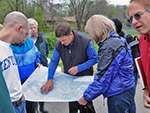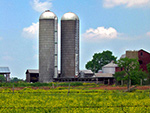In this Issue
Comprehensive Plan Update
Rural Crescent Changes Planned
Why Do Leaves Change Color?
Bird Walk at Merrimac Farm |

Your generous gifts help us stay strong. If you haven’t yet joined or need to renew your membership, please consider doing so now!
|
 Why Do Leaves Turn Color in Fall? Why Do Leaves Turn Color in Fall?
Plant cells contain chlorophyll, which is green. They also contain tiny grains of yellow and red-orange plant pigments, carotenoids.
We don’t see the color from these pigments during the summer because they are small and hidden by chlorophyll.
As daylight hours begin to shorten, changes take place in trees and they begin to prepare for the winter. Chlorophyll is no longer needed for food production. It begins to break down and lose its color.
This allows the carotenoids to show their colors. Leaves turn yellow or red-orange, the most common autumn colors.
Other pigments, anthocyanins, are linked with bright red, maroon, purple and blue colors.
These pigments are not present in the leaves during the summer. In autumn, a layer of cells forms between the leaf and branch.
This layer eventually stops the flow of water and nutrients into the leaf. It also prevents sugars from passing from the leaf to the tree.
The rising amounts of sugars in the leaf combine with bright sunlight to form water soluble pigments. The brightest red leaf contains the greatest amount of sugar.
Soil characteristics also affect the pigments: acid soil produces bright reds and alkaline soil produces purples and blues.
Different combinations of these three pigments result in the beautiful colors we enjoy seeing in autumn.
Leaves may be especially beautiful if there is plenty of rain in September followed by lots of sunny days and cold nights in October.
|
|
| Citizen Workshop on the Update of Prince William County's Comprehensive Plan |
 Thursday, October 13, from 6 to 8pm at the Development Services Building, 5 County Complex Court, Room 202A/B. Thursday, October 13, from 6 to 8pm at the Development Services Building, 5 County Complex Court, Room 202A/B.
On August 3, Supervisors approved the scope of work for an update of the Comprehensive Plan, which sets County policies for new development and affects all communities. It includes revisions to the following areas, and more:
- Rural Crescent/Urban Growth Boundary policies
- Re-planning for North Woodbridge, Parkway Employment Center, Innovation, the Fairgrounds/New Dominion Area, Independent Hill, Triangle, and Yorkshire
- Thoroughfare Plan (Transportation Chapter), including trails, road improvements, and VRE expansion proposals
- Economic Development policies
- Urban Development Areas
The workshop was just announced and there is not much information on the policies and areas that will be covered in the Comprehensive Plan Update. The Planning Office staff report is available online here.
A few questions we'll be asking are:
- How has the county documented the implementation of action items in current Comprehensive Plan chapters, including the Parks, Open Space, and Trails chapter?
- What economic development action items in the current Comp Plan are targeted towards improving agriculture-related businesses?
- What is the extent of planned updates to the Transportation Chapter?
Bring your questions and ideas, we'll see you there! |
| Supervisors Initiate Revisions to Rural Crescent Standards |
 The Rural Crescent establishes an Urban Growth Boundary, which gives Supervisors an effective tool to better manage sprawl development and focus infrastructure improvements where they are most cost-effective. The Rural Crescent establishes an Urban Growth Boundary, which gives Supervisors an effective tool to better manage sprawl development and focus infrastructure improvements where they are most cost-effective.
On September 20, Supervisors voted to initiate Zoning Text Amendments to:
- Create a Purchase of Development Rights Program
- Create a Transfer of Development Rights Program
- Amend Rural Cluster Development Regulations
This vote was just one stage of the challenge of protecting the Rural Crescent. While several Supervisors indicated they would set a high bar for cluster development, Supervisors Principi and Lawson were steadfast in their support for the Rural Crescent, as evidenced by their vote to deny changes to cluster development standards.
Cluster development is a development tool that would add more homes, expand public sewer into the protected rural area and blur the County's Urban Growth Boundary, in direct conflict with the County's smart growth principles.
A Transfer of Development Rights Program could add more houses in east Prince William, and even authorize commercial uses, without Supervisors having to take a vote and be accountable for the changes.
Purchase of Development Rights (PDR) is a proven, cost-effective conservation tool that permanently protects green open space and would send a clear message to local farmers that the County is willing to invest in their success.
A PDR program would also allow the County to take advantage of state and federal funding aimed at protecting farmland, without surrounding them with new houses where residents will object to farm noises, the smell of fertilizers, etc. Read more... |
| Bird Walk at Merrimac Farm WMA |
 October 30... on the last Sunday of every month at 8am October 30... on the last Sunday of every month at 8am
Meet at Merrimac Farm, Stone House, 15014 Deepwood Lane, Nokesville
We'll look for birds as we travel through the uplands to the edge of the floodplain, covering a variety of habitats, including open fields and woodland edges. Everyone is welcome.
View the bird list for Merrimac Farm here.
Dress for the weather, bring binoculars and cameras. More info and RSVP (appreciated) to PWCA , 703.499.4954 or [email protected]. |
|
|